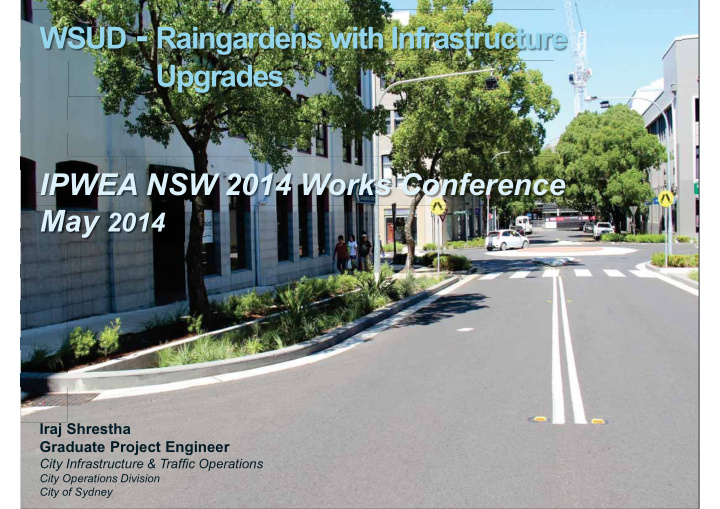



WSUD - Raingardens with Infrastructure Upgrades IPWEA NSW 2014 Works Conference May 2014 Iraj Shrestha Graduate Project Engineer City Infrastructure & Traffic Operations City Operations Division City of Sydney
City Of Sydney • 26 km 2 25% of NSW GDP 8% of National GDP 200,000 businesses 390,000 workers 1M visitors a day 4M tourists a year
Sydney 2030 Vision Th The Sustainable Sydney 2030 vision for a world- Th he Sustainable Sydney 2030 vision for a world he Sustainable Sydney 2030 vision for a world- leading metropolis requires the City to respond to le le ading metropolis requires the City to respond to ading metropolis requires the City to respond to di li i h Ci d We have the changes that are occurring through its growth. th th he changes that are occurring through its growth. he changes that are occurring through its growth h h i h h i owt h Th Th Th The overarching themes for Sydney 2030 are: h he overarching themes for Sydney 2030 are h hi h f S d 2030 e: committed to • • An integrated inner Sydney transport An integrated inner Sydney transport An integra egra network network network reducing • • A liveable green network A liveable green network A liveable green network • • Activity hubs as the focus for the City’s Activity hubs as the focus for the Cit Activity hubs as the focus for the City’s e Ci emissions by village communities and transport village communities and transport village communities and transport • • Transformative development and Transformative development and Transformative develo velo sustainable renewa sustainable renewal sustainable renewal al 70% • • A revitalised city centre at the heart of a A revitalised city A revitalised city centre at the heart of a city global Sydney global Sydney “By 2030, the City will reduce greenhouse gas “By 2030 the City will reduce greenhouse gas “By 2030, the City will reduce greenhouse gas emissions by 50% compared to 1990 levels, and emissions by 50% compared to 1990 levels and missions by 50% compared to 1990 levels, and i i 0% d 1990 l and d by 70% compared to 1990 levels by 2050.” by 70% compared to 1990 levels by 2050 b 0% d 1990 b 20 0.” 0 3
Sydney’s 2030 Vision • The Sustainable Sydney 2030 vision for a world- We will also leading metropolis requires the City to respond to the changes that are occurring through its growth. reduce The overarching themes for Sydney 2030 are: sediments and • An integrated inner Sydney transport network suspended • A liveable green network • Activity hubs as the focus for the City’s solids by 50% village communities and transport • Transformative development and and nutrients sustainable renewal • A revitalised city centre at the heart of a by 15% which global Sydney are discharged “By 2030, the City will reduce the whole City’s mains water consumption by 10% of 2006 into the levels. .” waterways
Raingarden Deployment • Since 2008 the City has constructed 106 raingardens • Covering over 2300 m 2 • Multiple benefits such as water quality improvement, increased greenery, traffic calming and increased amenity
TYPICAL RAINGARDEN DESIGN
Raingardens – Lining Materials Polypropylene Shotcrete
Raingarden Size & Depth Limitations • Limited locations in highly urbanised areas • Competing priorities such as removing parking or encroaching on to footway • Generally located in kerb extensions in no stopping zones
Raingarden Size & Depth General Dimensions • Ideal water ponding depth 150 – 200 mm • Maximum ponding depth 300 mm • Minimum size 6 m 2 , Average size 20 m 2
Raingardens – Poor Outcomes • Small, narrow and shallow raingardens are prone to problems
Raingardens – Impacts of Trees • Incorporating existing trees into unlined systems • Damage to tree during construction • Damage to liner • Shading effects • Leaf litter
Raingardens – Selecting the Type • Knowledge of the soil & ground water characteristics of the local environment • Unlined where practical
Raingardens – Layer Tolerances • Attention to detail • Layer thickness control • Educating staff and contractors • Use experienced consultants to build knowledge and skills • Do not overfill
Raingardens – Water Entry Points • Erosion control • Silt and debris build up at entrance • Multiple dissipation arrangements trialled • Drop water in to raingarden
Raingardens – Water Entry Points • Stop silt and debris entering vegetated area • New entry pit designed and trialled • Reduced maintenance • Improved visual appearance
Raingardens – Plant Selection • Highly visible in urban environment • Use larger plants and dense planting • Instant green impact • Cost effective
Raingardens – Plant Selection • Adjust planting scheme to suit community expectations • Structured or unstructured
Raingardens – Recycled Materials • Recycled glass in transition layer and pipe backfill • Green Star concrete in construction works
Raingardens – Performance Monitoring
Recommend
More recommend